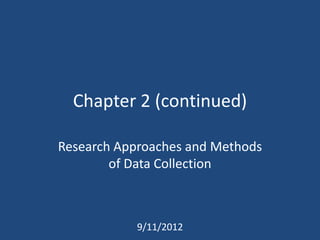
Chapter 2 class version b
- 1. Chapter 2 (continued) Research Approaches and Methods of Data Collection 9/11/2012
- 2. Roadmap • Confirm roster • Quick review of last class • Finish chapter 2 material • Where we’re headed: – Finish ch. 2 today – Chapter 3 on Thursday – Next Tuesday: Exam 1
- 3. Quick Review • Variables in psychology research – Types – Roles • Quantitative vs. Qualitative research • Experimental research and causation – Requirements for claims of causation • Settings for experimental research – Pros and cons
- 4. Where we left off… • Reminder of qualitative vs. quantitative • “zoom out” • Other (non-experimental) quantitative research designs
- 5. Nonexperimental Quantitative Research • A descriptive type of research study • Defining characteristic: no IV manipulation • Goals – Provide an accurate picture of phenomenon – Describe size and direction of relationships among variables • Question: If we care so much about causation, why would we use this kind of research design?
- 6. Types of Nonexperimental Quantitative Research • Correlational Studies • Natural Manipulation • Longitudinal and Cross-Sectional
- 7. Correlational Research • A study that describes the relationship between two variables • The goal is often to help with prediction. • Remember the 3rd variable problem.
- 8. Remember: Correlation does not imply causation. Correlation does not imply causation. Correlation does not imply causation. Correlation does not imply causation. Correlation does not imply causation. Correlation does not imply causation. Correlation does not imply causation. Correlation does not imply causation. Correlation does not imply causation. Correlation does not imply causation. Correlation does not imply causation. Correlation does not imply causation.
- 9. Natural Manipulation Research (a.k.a. quasi-experimental) • Look at effects of variable(s) not actually under the experimenter’s control • Examines the impact of individual difference variables on an outcome variable • Individual difference variables are existing characteristics such as traits, characteristics, experiences* – Examples?
- 10. Longitudinal & Cross-Sectional Designs • Zoom out: still non-experimental quantitative research
- 11. Longitudinal Research • A study that repeatedly measures the same variables in a single sample of individuals over a set time • The time period can vary greatly. • At least two measurement points, but can be more
- 12. Cross-sectional Research • Measure variable(s) across representative samples of individuals that differ on a characteristic • Key: measure all at one time point
- 13. Comparing Longitudinal and Cross-Sectional • Both have benefits and drawbacks: • Time to complete the study • Feasibility to complete the study • Richness of data • Cohort issues
- 14. Cohort effects • Different age groups have different experiences over time – Example: • A group of 10-15 year-olds have always used computers • A group of 60-65 year-olds did not routinely use computers until they were adults (and some still may not)
- 15. Cohort-Sequential Design • A combination of longitudinal and cross- sectional designs • Measures the same characteristics at several selected time intervals in groups at different age levels • Benefits: less time, less cost, lower attrition
- 16. Example: • Formation and maintenance of best- friendships in children as they advance from 2nd grade to 5th grade • What would this look like in a longitudinal study? • Let’s see what a cohort-sequential design would look like
- 17. Fall Spring Fall Spring 2012 2013 2013 2014 Group (Starting Point) 2nd graders 2nd 2nd 3rd 3rd 4th graders 4th 4th 5th 5th • Now you can collect data spanning from 2nd grade to 5th grade in half the time
- 19. Qualitative Research • Interpretive research approach relying on multiple types of subjective data • Researcher’s goal: understand observations from the participant’s perspective
- 20. Features of Qualitative Research • Generally occurs in the field or participant’s natural setting • Triangulation • deeper understanding of phenomena • Research questions may evolve over course of data collection
- 21. Major Methods of Data collection • Techniques used to physically gather information used to answer research questions • Tests • Questionnaires • Interviews • Focus groups • Observation • Existing/ Archival data
- 22. Tests • Standardized or researcher-constructed instruments designed to measure: – Personality, aptitude, achievement, performance • Information on reliability, validity, and norms usually available • Table 2.3, page 55- benefits/weaknesses
- 23. Questionnaires • Self-report data collection instrument – opinions, perceptions, attitudes • Paper-and-pencil, computer, online • Table 2.4, page 57
- 24. Interviews • Data collection method in which an interviewer asks the interviewee a series of questions • Face-to-face, telephone • Table 2.5, page 58-benefits/weaknesses
- 25. Focus Groups • Collection of data in a group situation in which a moderator leads a discussion with small group of participants. • Especially useful for exploring how people think about an issue – The difficulties of focus groups – Table 2.6, page 59-benefits/weaknesses
- 26. Observation • Researcher observes and records individuals’ behavior • Naturalistic—real-world setting • Laboratory—in a lab or other controlled setting created by the researcher • Table 2.7, page 60-benefits and weaknesses
- 27. Existing or Secondary data • Collection of data left behind or originally used for another purpose. • Documents • Physical data • *Archived research data • Table 2.8, page 61-benefits and weaknesses